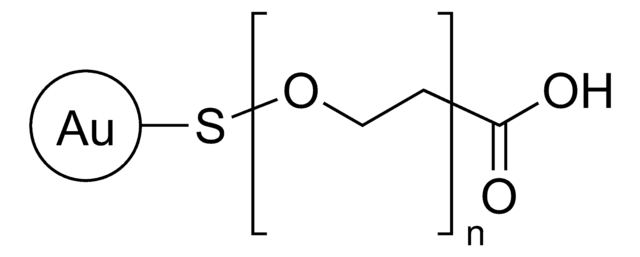753645
Gold nanoparticles
50 nm diameter, OD 1, stabilized suspension in 0.1 mM PBS, reactant free
Synonyme(s) :
Au NP, Gold colloid
About This Item
Produits recommandés
Niveau de qualité
Forme
nanoparticles
suspension
Conditionnement
poly bottle of 100 mL
poly bottle of 25 mL
Conditions de stockage
do not freeze
Concentration
~3.5E+10 particles/mL
DO
1
Diamètre
50 nm
λmax
531-535 nm
PDI
<0.2
Température de stockage
2-8°C
Chaîne SMILES
[Au]
InChI
1S/Au
Clé InChI
PCHJSUWPFVWCPO-UHFFFAOYSA-N
Vous recherchez des produits similaires ? Visite Guide de comparaison des produits
Catégories apparentées
Description générale
Application
- As conductors in printable inks,
- In Photodynamic therapy,
- In drug delivery and biomarkers,
- As calorimetric sensor,
- In biological imaging,
Informations légales
Code de la classe de stockage
12 - Non Combustible Liquids
Classe de danger pour l'eau (WGK)
nwg
Point d'éclair (°F)
Not applicable
Point d'éclair (°C)
Not applicable
Faites votre choix parmi les versions les plus récentes :
Déjà en possession de ce produit ?
Retrouvez la documentation relative aux produits que vous avez récemment achetés dans la Bibliothèque de documents.
Les clients ont également consulté
Articles
Surface-enhanced Solar Energy Conversion Systems Using Gold and Silver Nanoparticles
Steven J. Oldenburg, Ph.D. provides an overview of lateral flow diagnostic assays and discusses the use of ultra-bright reporter particles based on the unique optical properties of gold nanoshells that significantly increase the sensitivity of lateral flow immunoassays.
Gold (Au) nanoparticles have tunable optical and electronic properties and are used in a number of applications including photovoltaics, sensors, drug delivery & catalysis.
Gold (Au) nanoparticles have tunable optical and electronic properties and are used in a number of applications including photovoltaics, sensors, drug delivery & catalysis.
Notre équipe de scientifiques dispose d'une expérience dans tous les secteurs de la recherche, notamment en sciences de la vie, science des matériaux, synthèse chimique, chromatographie, analyse et dans de nombreux autres domaines..
Contacter notre Service technique


